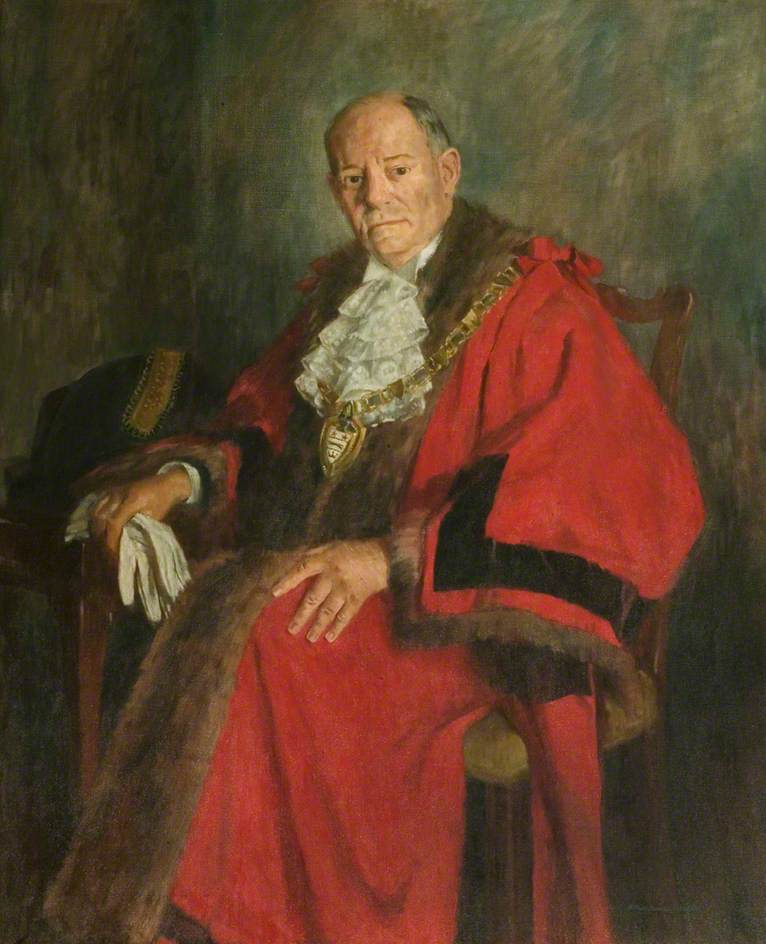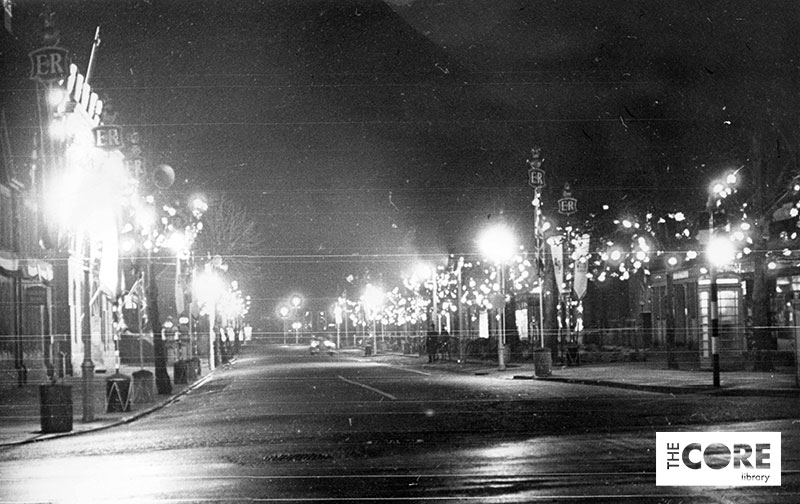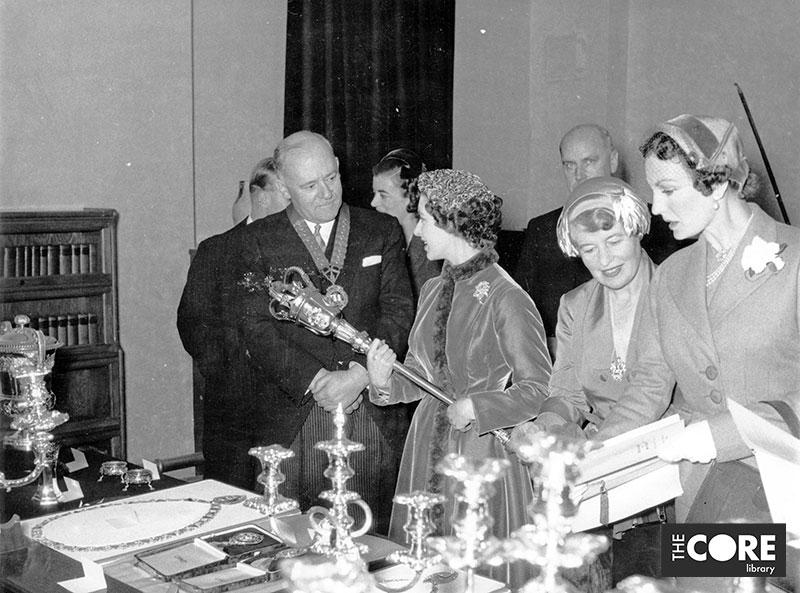On Solihull’s Charter Day, 11th March 1954, H.R.H. Princess Margaret visited Solihull on behalf of the Queen to present the Urban District with a Royal Charter of Incorporation as a Borough. Although the elevation to a borough was important in Solihull’s journey to become a County Borough, it did not bestow any new powers on Solihull, apart from the new Borough having a Mayor instead of the previous Chairman of Solihull Urban District.
The journey to becoming a Borough
For much of its history, Solihull was a quiet, rural village in the county of Warwickshire. When local government below county level was reorganised under the Local Government Act 1894, Solihull became a Rural District.
In 1921, the parish of Solihull (including Olton and Shirley) had a population of 10,662. In 1931, an inquiry into boundary changes estimated that this had increased to 20,961
In 1932, Solihull changed from a Rural District to an Urban District, marking the start of its official transition from “the village,” as it was known to Silhillians to a modern town. The change in status meant that the Council was entitled to take on additional powers such as public health functions and housing. At this time, the population of the district was around 25,000.
At the official opening of Solihull Council House in Poplar Road in 1937, Sir John Mellor M.P. stated that the estimated population of the district was then around 40,000, and described the 60 per cent increase in population over five years as “phenomenal.” He went on to say that it almost suggested the time was ripe for Solihull to receive a Charter of Incorporation as a Borough.
In 1938, a special committee appointed by Solihull Urban District Council recommended that the Council should discuss making a petition for Incorporation as a Borough. However, these preliminary steps were shelved when war broke out in 1939.
Borough status may only be granted by the monarch, usually on the advice of the Privy Council. However, for the duration of the Second World War, the Privy Council would not consider any alterations to the status quo in local government. Solihull Council was then asked to postpone any petition until the post-war work of the Boundary Commission was completed. This boundary review was terminated in 1950 and Solihull Council then decided that the time was right for it to submit a petition.
The 1951 census showed that Solihull’s population was 67,977 – making it the largest district in Warwickshire, comparable only to Nuneaton. By 1954 it was in excess of 70,000 – larger than 90 per cent of the existing municipal boroughs – and still growing. This was despite the almost complete cessation of building work during the war.
Solihull was the largest of the district authorities in Warwickshire and Town Clerk, W. Maurice Mell, pointed out the incongruity of Solihull’s population being larger than the combined population (66,000) of Warwick, Leamington and Stratford, despite each of those three authorities being a chartered borough with a Mayor and a corporation.
Mr R. J. Turner, Vice-Chairman of Solihull Urban District Council in 1937 said:
the extraordinary (but quite comprehensible) popularity of Solihull with Birmingham people was causing the Council some difficulty. The newcomers to Solihull wanted all the amenities in the way of public services to which they had been used in Birmingham and, in addition, they wanted the rural character of Solihull to be maintained.
Birmingham Daily Gazette, 25th March 1937
Petition
In May 1951, Solihull Urban District Council submitted a petition to His Majesty’s King George VI, praying for the Sovereign to exercise his Royal Prerogative in granting to Solihull a Charter of Incorporation as a municipal borough.
In response to the petition, the Sovereign’s advisors had to carry out a diligent investigation into the governance of Solihull, as well as into its community life. The charitable, cultural and social organisations were all the subject of the enquiry. By the time the enquiry took place, King George had died and Queen Elizabeth II had acceded to the throne.
A public enquiry was held on 21st May 1952 at the Council House in Poplar Road, Solihull. Only one objection was made – by a Mr A. J. Smith of Streetsbrook Road. He did not appear in person but wrote to say that he felt “the vast majority of the ratepayers and population are against any change in the present status.” Nineteen witnesses spoke in support of the petition, including the Chairman of Warwickshire County Council who said that Solihull’s petition had the full support of the county council.
Mr Mell, Clerk to the Council, at the enquiry summed up the modern Solihull in these words:
Solihull is infinitely bigger than any of the incorporated boroughs of Warwickshire. Except for Rhondda, it is the largest urban district outside London. It has developed a civic life. The Council have administered the affairs of the district honestly, fairly and impartially, and I submit, with noteworthy efficiency. It is my submission that it is well worthy of the higher status it is now seeking…
Evening Despatch, 11th March 1954
In August 1953 the Council was informed that the Petition was approved, although it was not announced publicly until 4th January 1954, when it was proposed that Princess Margaret would make an official visit on behalf of the Queen to present the Charter.
On 1st March 1954, the Privy Council advised Queen Elizabeth II to grant a Charter of Incorporation creating the urban district of Solihull a municipal borough. This was the first such charter to be granted during the reign of Her late Majesty, Queen Elizabeth II.
Charter Day
Preparations began weeks before the visit of Princess Margaret. On 23rd February 1954, the first decorations – strings of red, white and blue lights – were installed in Brueton Gardens, Warwick Road. The Council House in Poplar Road was decorated with flags, drapes and shields bearing Princess Margaret’s personal cypher and the Solihull Coat of Arms.
Most shops and offices in Solihull closed for the day to allow their staff to welcome the Princess, and 12,000 children were given the day off school.
Princess Margaret, wearing a grey-green velvet coat trimmed with brown fur, arrived by train (pulled by the steam engine Tenby Castle) at Solihull Station at 10:25am and was greeted by the Lord Lieutenant of Warwickshire, Lord Willoughby de Broke. After leading citizens and their wives were presented to her the Princess was driven along Station Road, Blossomfield Road, Longmore Road and Stratford Road to the Odeon cinema, Shirley. This was the only building in the district large enough to accommodate the invited guests.
A bouquet of orchids was presented by nine-year-old Penelope Mell, daughter of Solihull’s Town Clerk.
Presentation of the Charter
An audience of 1,200 people witnessed the Presentation of the Charter, whilst thousands more heard the ceremony broadcast over loudspeakers outside.
The stage and foyer were carpeted with Persian carpets and contemporary decorations. The Band of the Royal Warwickshire Regiment played, among other pieces, a selection from “Guys and Dolls,” one of the Princess’s favourite musical shows.
As the Princess stepped into the cinema, more presentations of local councillors and civic officials took place. Her entry into the auditorium was marked by the playing of a fanfare by seven trumpeters of the Warwickshire Regiment. The Princess moved to the stage and the “simple but dignified ceremony” began with the playing of the National Anthem.
As she left the Odeon, the Princess took the Brownies by surprise, walking up and down the lines of Guides and Brownies and stopping to speak to them. The Princess was then driven to Solihull along Solihull Road, Sharmans Cross Road, Streetsbrook Road, Station Road and Poplar Road.
The presentation ceremony had lasted less than the allotted time so, on her drive to the Council House to inspect the civic regalia, Princess Margaret, who was 20 minutes ahead of schedule, broke her journey at the Parish Church of St Alphege. This came as a great surprise to 71-year-old parish verger, Walter Hillsdon, who was the sole official at the church able to welcome the Royal party. He gave a guided tour whilst a message was hurriedly sent to the Rector, Rev. Harry Hartley, who was still at Shirley.
Solihull Council House
A huge crowd – including around 3,000 school children – packed Poplar Road to witness the Princess’s arrival at the Council House. Amongst the crowd were boys of the Naval, Army and Air sections of Solihull School’s Combined Cadet Force, as well as children from four local schools – Solihull School, Solihull High School for Girls, Lode Heath Secondary School, and Windylow. There were also Girl Guides, Sea Rangers and Brownies lining the red carpet leading into the building.
On arrival at the Council House the Princess was greeted with a fanfare from the trumpets of the Royal Warwickshire Regiment and was invited to sign the Distinguished Visitors’ Book. As a souvenir of her visit, she accepted a gold powder compact bearing her own cypher and a coronet in white gold.
In an ante-room adjoining the assembly room of the Council House, Princess Margaret examined the civic plate and regalia. Before leaving, she appeared on the balcony of the building, acknowledging the cheers of the crowds below.
Charter Luncheon
From the Council House, the Princess was driven along Warwick Road, Richmond Road and Lyndon Road past cheering crowds to Lyndon Secondary Modern School, where she attended a special lunch.
Lyndon School was designed by Coventry architects Rolf Hellberg and Maurice Harris, in collaboration with Warwickshire’s County Architect and was built by Thomas Bates and Son of Coventry. The school had opened in September 1952 and was considered one of the showpieces of the Midlands, incorporating “every possible modern development and improvement in school architecture.”
Grace was said by the Rector of Solihull and a Loyal Toast was proposed by the Chairman of the Council. The menu for the 240 guests at the Charter Luncheon included:
- smoked salmon
- tournedos of beef with chateau potatoes and cauliflower fritter
- pineapple charlotte
- a selection of cheeses and biscuits
The meal was prepared and served by a catering staff of 50, who used extra cooking equipment specially installed at the school.
After departing the Charter Luncheon at 2:25pm, Princess Margaret was driven via Lode Lane and Warwick Road to RAF Honiley to present new colours to 605 (County of Warwick) Squadron Royal Auxiliary Air Force.
The squadron was one of the first RAF auxiliary units and was formed at Castle Bromwich in October 1926. Originally a bomber unit, it was converted to a fighter squadron on 1st January 1939. The Queen’s standard presented by Princess Margaret had been awarded in October 1953 in recognition of the squadron’s more than 25 years of service by 1st April 1953.
The squadron was stood down in 1957 when Royal Auxiliary Air Force units were all disbanded. The “stand down” photograph of the squadron was taken on 20th January 1957, and the colours were laid up at St Mary’s Church, Warwick in a ceremony on 10th March 1957.
Solihull’s first Mayor
Councillor Robert Douglas Cooper (1898-1969), who became Chairman of Solihull Urban District Council in May 1953, was nominated as Mayor-designate of the new Solihull Borough Council. He had been a member of the Council since 1946 and, before being elected Chairman of the Council, was Chairman of the General Purposes and Finance Committees. He was also a Governor of Solihull School.
Councillor Cooper assumed the office of Mayor of Solihull on 24th May 1954 – the day that the Charter of Incorporation came into effect. His wife, Doris Marjorie (1899-1978) became the Charter Mayoress.
Artist Bernard Fleetwood Walker (1893-1965) was commissioned to paint a portrait of Solihull’s first Mayor, which now hangs in Solihull’s Civic Suite.

It was usual practice for Boroughs to have a Mayoral limousine in which the Mayor would be driven to and from official engagements. By a happy coincidence, it was realised in 1954 that the “SOL 1” registration would soon be coming up for first registration with Birmingham City Council. The Town Clerks of the respective councils agreed that “SOL 1” would be reserved for a Mayoral vehicle for the new Solihull Borough.
May 1954
The Charter came into effect at noon on Monday 24th May 1954, with the first meeting of Solihull Borough Council taking place in the Assembly Rooms before almost 300 people. Proceedings were relayed to members of the public in the adjoining hall. At three minutes before noon, Councillor R. Douglas Cooper entered the council chamber and spoke of the passing of the urban district, removing his chain of office as Chairman of Solihull Urban District Council at noon precisely.
He was then unanimously elected Mayor by fellow councillors and, after signing the declaration of acceptance, retired from the chamber to re-enter a few minutes later in his scarlet Mayoral robes. The civic mace was placed on its stand in the chamber. Telegrams of loyalty were approved for despatch to the Queen and Princess Margaret and, following the closure of proceedings, a civic luncheon was held at Solihull School.
On the evening of Monday 24th May, a five-day fair began in Malvern Park in aid of charity, and hundreds of fairy lights threaded through the branches of trees in Poplar Road were lit, as they would be each evening for the rest of the week. The “Cuckoo in the Window” competition also took place during the week, with scores of school children scrutinising shop windows at lunchtimes and evenings, trying to identify the goods not usually sold in the shops concerned.
Solihull Carnival, which had last been held in 1939, was revived for the Charter celebrations and took place on Saturday 29th May 1954, being described as the culmination of Solihull’s Charter celebrations and lasting for nine hours. The Charter Carnival began at 1:30pm with singing by massed choirs and an Elizabethan Pageant performed outside St Alphege Church by three sections of the Solihull Society of Arts.
The 17-year-old Carnival Queen, Wendy Izon, rode in a horse-drawn golden coach as part of a mile-and-a-half 60-vehicle procession organised with military precision by the Solihull Home Guard Association whose members communicated via walkie-talkie.
Motor cycle displays, sheep-dog trials, tennis and outdoor dancing saw celebrations continue through the afternoon and into the evening, culminating in a torchlight procession through the town and a mammoth firework display in Malvern Park. Watched by a crowd of about 10,000 people, the 45-minute display – billed as one of the biggest ever seen in Solihull – included rockets, giant Catherine wheels, and a giant picture of the Queen picked out in thousands of fireworks.
On Sunday 30th May, members of various youth organisations voluntarily cleared up the litter and rubbish left by merry-makers in Malvern Park. Beginning work at 7am, the volunteers had made the park tidy again by 11am.
To mark the change in status, the local newspaper – the Solihull & Warwick County News – changed its name to the Solihull News as the paper felt that the new Borough deserved a newspaper all of its own.
A group of local photographers and film-makers put together a film of the day’s events and, after a “premiere” in December 1954, donated it to Solihull Council with the intention of it forming part of the Council’s archives. The film has been digitised for Solihull Libraries by the Media Archive for Central England (MACE) and is freely available to view via BFI Player
Bells for the Borough 2024
Church bells will ring out at 7.30pm on 11th March 2024 to commemorate the anniversary. Listen out for the bells at:
- St Swithin’s, Barston
- St John Baptist, Berkswell
- St Peter’s, Bickenhill
- St Patrick’s, Salter Street, Earlswood
- St James, Shirley
- St Alphege, Solihull
If you have any further information about Charter Day, please let us know.
Tracey
Library Specialist: Heritage & Local Studies
email: heritage@solihull.gov.uk
© Solihull Council, 2024.
You are welcome to link to this article, but if you wish to reproduce more than a short extract, please email: heritage@solihull.gov.uk










Leave a comment